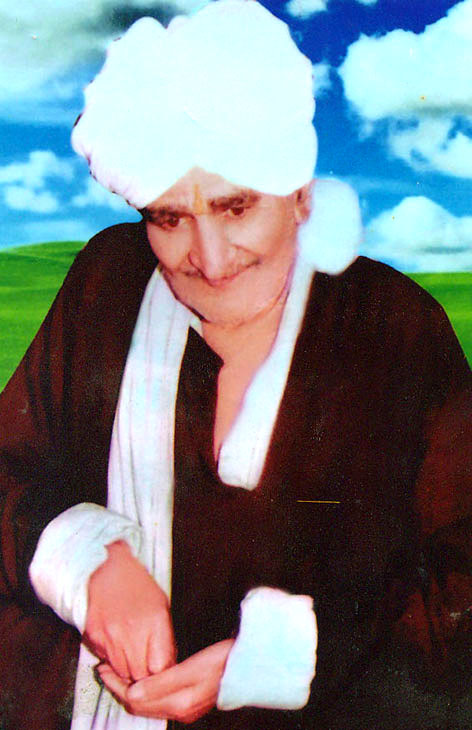R K Pandita
After the mass exodus of Kashmiri Pandits in 1990, they had to fight for survival under extremely difficult conditions. But their faith in Almighty proved their strength to face the hostile circumstances. Right from day one of displacement they also began to reconstruct their draughts of religious and spiritual icons. The building up of Ashram and installing the statue of Sedabab at Paloura is a glaring example of the unflinching faith of the disciples of Sedabab despite of the truth that Sedabab was not in favour of any kind of exposure.
The aroma of Kashmir valley was already scented with the blessings of saints and Munis. And to add to it, it was Navmi of Jeshta Shukla Paksh, when a male child was born to Shri Veshna Bhat and Shrimati Yemberzal of Hanjiveira, Pattan Kashmir who later came to be known as Sedabab. Sedabab was called Ved Lal in his early life and was married to a very faithful, dedicated and hardworking woman called Gunawati, the embodiment of virtues. Sedabab like a common Kashmiri Pandit performed all his mundane and domestic responsibilities. But the destiny had to induce the urge of spirituality in Sedabab with every tick of the arms of the clock. He began to visit various temples and shrines of great reverence. He also met saints and seers to seek guidance for his spiritual urge. Among other highly spiritual and enlightened souls he had a great influence of Swami Nand Lal Ji. He was so near and dear to Sawmi Nand Lal Ji that he would call him Sedamol.
The light of serenity, piousness and spirituality does not remain limited to the borders of any kind. It enlightens the whole ambience. And hence, day after day, the name of Sedabab reached most of the Kashmiri Pandits throughout length and breadth of Kashmir. His spiritual insight, magnetic hold and his glorious and shining personality attracted many to become his followers. His followers were not restricted within any particular circle but even Muslims became his disciples and sought his blessings. Highly spiritual Sedabab never ran away from his domestic obligations but at the same time his desire for complete unison with almighty never faded. And like a lotus, he attained what others don’t achieve even after performing rigorous austerities.
There is an instance which is even today a Margdarshan for many who despite being enlightened are bound by the shackles of Moha. Sedabab’s second son, Omkar Nath, was performing his duties in Indian Army. India-China war broke out in 1962. Omkar Nath fell to the bullets of the enemy and attained martyrdom. The news of the death of Omkar Nath shook everyone especially his family members. But Sedabab was unaffected and was in schedule stopover. He did not shed even a single drop of tear. This proved that despite being in the domestic world, he was completely in unison with the Almighty and was unmoved with warp and whoop of mundane-life.
Simple, calm and affectionate, Sedabab used to wear a turban, pheran, a shawl and used to besmear tilak on his forehead regularly. After a bath he would remain in meditation for long hours. He read Gita, Panchastawi and Mahimnapar which mesmerised his followers. Being strictly vegetarian he did not eat onions or garlic. Kashmiri Kehwa was his favourite.
There is a difference of opinion as who was the Spiritual Guru of Sedabab but mostly accepted opinion is that his Guru was Swami Nand Lal JI. Some also believe that he was Guru of his own. Because, Sedabab was not in practice of unfolding things easily, so nothing can be said with authenticity. But it is proved that Swami Sedabab showered blessings to his devotees, though not easily but surely. And it is also evident that he was against any kind of publicity and that is why this exercise is more or less practised by his followers even today. His followers even believe that it was Sedabab’s wish that his disciples could not make his Samadhi. It happened so that on October 31, 1985 Sedabab attained eternal Samaadhi at his Hanjiveira residence.
The news spread like a wildfire and the administration had to face enormous difficulties in managing the crowd. After some days his devotees tried to construct a memorial in his name at Shumshan Bhumi but it failed due to the strong objection raised by Muslims and the construction was given a stay order by the court.
Thus the land of Hanjiveira, Pattan has the credit of giving the birth to a great saint but, today, in exile, where the Ashram of Sedabab is located is not less blessed. Yagya is performed here twice a year where hundreds of devotees come, take the prashaad with utter surrender and faith and get blessed.
Trending Now
E-Paper


